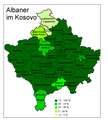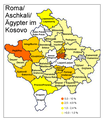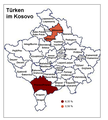Ethnic groups in Kosovo
In addition to the Kosovar Albanians , who make up the majority of the population, live in Kosovo as well as a number of ethnic groups ( ethnic groups ), the largest of which is that of the Serbs . There are also Turks , Bosniaks , Croats ( Janjevci ), the Slavic-speaking Muslim Torbeschen and Gorans , the Roma and the Ashkali and Egyptians ( Balkan Egyptians ) who belong to the Roma groups.
historical development
| year | Albanians | Serbs | Other |
|---|---|---|---|
| 1948 | 68.5% | 23.6% | 8th % |
| 1953 | 64.9% | 23.5% | 11.6% |
| 1961 | 67.2% | 23.6% | 9.3% |
| 1971 | 73.7% | 18.4% | 8th % |
| 1981 | 77.4% | 13.2% | 8th % |
| 1991 | 81.6% | 9.9% | 8th % |
| 2000 * | 88% | 7% | 5% |
| 2006 * | 92% | 5% | 3% |
| * Estimated data Source: Military History Research Office (MGFA), Guide to History - Kosovo , Weltband (for 2000) and OSCE (for 2005) |
|||
Kosovo has been multiethnic since the early Middle Ages. The various ethnic groups lived largely apart from one another; Marriages between Albanians and Serbs were rare even during communist Yugoslavia . Since the 1960s there has been a tendency towards ethnic unification of residential areas. Ethnically mixed residential areas have been the exception since the 1980s.
The statistics show that the proportion of minorities in the total population of Kosovo has decreased significantly over the past 25 years. The last official census (1981) in the former Yugoslavia showed a majority of 77.4% Albanians. According to estimates by the World Bank , which were taken over by the Statistical Office of Kosovo, their share rose to around 88% by the year 2000 and subsequently increased by a further three percentage points, according to OSCE reports.
Current situation
Since the war in Kosovo , an estimated 240,000 members of the minorities have lost their place of residence through flight or displacement. This figure is based on information from the Serbian government and is supported by other comparative figures . Between 2000 and November 2004 inclusive, over 12,000 returned to the province voluntarily. The demographic majority of Albanians has increased even further as a result of this flight since the Kosovo war.
Overall, the fighting between Serbs and Albanians, coupled with expulsions, has meanwhile resulted in large parts of the ethnic groups being separated into clearly defined areas. The remaining minorities either live in coherent larger areas or in enclaves , i.e. in individual villages, districts or complexes of houses.
According to a March 2005 UNHCR report, members of minorities are still exposed to ethnically motivated attacks “in which transports are stone pelted, individuals are physically assaulted, harassed or intimidated, or in which the property and possessions of ethnic minorities are looted , destroyed or illegally confiscated, cemeteries and grave sites desecrated and hate speech written on the walls of public buildings. "
Regional settlement areas
The table and the maps show where in 2005 which minorities were located in the then thirty large municipalities of Kosovo (source: OSCE reports 2005 ). Today Kosovo is divided into 38 municipalities .
| Municipality (Albanian / Serbian) | number of inhabitants | Albanians | Serbs | Roma / Ashkali / Egyptians | Turks | Bosniaks | Gorans | Other |
|---|---|---|---|---|---|---|---|---|
| Deçan / Dečani | 50,500 | 50,000 | 22nd | 423 | not specified | 51 | k. A. | k. A. |
| Dragash / Dragaš | 34,562 | 24,856 | k. A. | k. A. | k. A. | k. A. | 9,706 | k. A. |
| Gjakova / Đakovica | 153,000 | 143,300 | 6th | 6,700 | k. A. | 60 | k. A. | k. A. |
| Drenas / Glogovac | 70,400 | 70,400 | k. A. | k. A. | k. A. | k. A. | k. A. | k. A. |
| Gjilan / Gnjilane | 129,690 | 116,000 | 12,300 | 350 | k. A. | k. A. | k. A. | 1005 |
| Istog / Istok | 44,610 | 41,000 | 540 | 1,740 | k. A. | 1,330 | k. A. | k. A. |
| Kaçanik / Kačanik | 43.009 | 43,000 | k. A. | 9 | k. A. | k. A. | k. A. | k. A. |
| Kamenica / Kosovska Kamenica | 63,000 | 52,000 | 10,500 | 500 | k. A. | k. A. | k. A. | k. A. |
| Klina | 54,900 | 53,000 | 94 | 1,800 | k. A. | k. A. | k. A. | k. A. |
| Fushë Kosova / Kosovo Polje | 40,000 | 34,000 | 3,239 | 2,647 | k. A. | k. A. | k. A. | 21st |
| Leposaviq / Leposavić | 18,500 | 67 | 18,000 | 203 | k. A. | k. A. | k. A. | 240 |
| Lipjan / Lipljan | 76143 | 63,478 | 9,300 | k. A. | k. A. | k. A. | k. A. | 2,253 |
| Malisheva / Mališevo | 65,520 | 65,500 | k. A. | 20th | k. A. | k. A. | k. A. | k. A. |
| Mitrovica / Kosovska Mitrovica | 107.045 | 95,000 | 10,400 | 545 | 600 | k. A. | k. A. | 2,000 |
| Novobërdë / Novo Brdo | 3,751 | 2,300 | 1,400 | k. A. | k. A. | k. A. | k. A. | 51 |
| Obiliq / Obilić | 28,653 | 24,000 | 3,425 | 1,141 | k. A. | k. A. | k. A. | 82 |
| Rahovec / Orahovac | 78.297 | 76,577 | 1,300 | 420 | k. A. | k. A. | k. A. | k. A. |
| Peja / Peć | 91.112 | 78.712 | 1,000 | 6,300 | k. A. | 5,000 | k. A. | k. A. |
| Podujeva / Podujevo | 131,300 | 130,200 | 27 | 1,067 | k. A. | k. A. | k. A. | k. A. |
| Prishtina / Pristina | 564,800 | 550,000 | 12,000 | 1,000 | k. A. | k. A. | k. A. | 1,800 |
| Prizren | 221.374 | 180.176 | 194 | 5,148 | 14,050 | 21,266 | k. A. | k. A. |
| Skënderaj / Srbica | 70,414 | 70,000 | 326 | 68 | k. A. | 20th | k. A. | k. A. |
| Shtërpca / Štrpce | 13,633 | 4,500 | 9,099 | 34 | k. A. | k. A. | k. A. | k. A. |
| Shtime / Štimlje | 29,000 | 28,247 | k. A. | 738 | k. A. | k. A. | k. A. | k. A. |
| Suhareka / Suva Reka | 80,460 | 80,000 | k. A. | 460 | k. A. | k. A. | k. A. | k. A. |
| Ferizaj / Uroševac | 143,842 | 140,000 | 147 | 3,594 | k. A. | k. A. | k. A. | 248 |
| Vitia / Vitina | 59,810 | 56,400 | 3,300 | 20th | k. A. | k. A. | k. A. | 60 |
| Vushtrria / Vučitrn | 102,662 | 98,000 | 4.137 | 525 | k. A. | k. A. | k. A. | k. A. |
| Zubin Potok | 14,800 | 800 | 14,000 | k. A. | k. A. | k. A. | k. A. | k. A. |
| Zveçan / Zvečan | 16,600 | 350 | 12,050 | k. A. | k. A. | k. A. | k. A. | 4,450 |
Overview maps
Minority Political Organizations
The minorities in Kosovo are usually politically organized, and many of the minority parties are represented in Kosovo's parliament. The parliamentary representation of the minorities is assured: in the 120-member Kosovo parliament, 10 seats are reserved for representatives of Kosovar Serbs, four seats for Roma, Ashkali and Egyptians, three for Bosniaks, two for Turks and one for Gorans.
Refugees from Kosovo
Because of the persecution of ethnic minorities in Kosovo, many members of these groups fled to Serbia and Montenegro or Western and Central Europe.
Germany
According to the Permanent Conference of Interior Ministers , around 38,000 refugees from ethnic minorities from Kosovo lived in Germany in 2004. There is a readmission agreement with Kosovo. Germany is repatriating members of ethnic minorities to Kosovo, some of which are compulsory. It is estimated that 2,500 repatriation applications will be filed each year. 14,000 people from the Roma minority group are particularly hard hit by the deportation .
On December 19, 2011, the then federal government issued a detailed position on the deportation of Roma to Kosovo in Bundestag printed paper 17/8224. In it she gave the number of tolerated people from Kosovo as 5574 and those from Serbia as 11,819.
On December 17, 2013, the parliamentary group Die Linke made a similar small request to the new federal government . 'Die Linke' writes in it, "The solution [could] only consist in a generous regulation of the right to stay for members of minorities from Kosovo."
There is a central register for foreigners in Germany . There (as of December 2011) no information on ethnicity or region of origin is recorded.
Serbia and Montenegro
According to the UN refugee organization UNHCR, there are over 220,000 displaced persons from Kosovo in Serbia and Montenegro. “Refugees and internally displaced people are competing for resources that are already scarce in an environment characterized by high unemployment, the general collapse of social security systems and drastically declining international aid measures for displaced persons. In view of these conditions, the displaced are faced with difficult challenges in their efforts to achieve a reasonably adequate standard of living. Members of minorities who belong to the group of internally displaced persons are in the vast majority not able to integrate into the host society of Serbia and Montenegro or at least to live there under reasonably dignified conditions, ”says a UNHCR situation report.
Of the members of ethnic minorities who fled after the NATO invasion of 1999, only 16,100 had returned to their home communities by the beginning of 2007.
literature
- Jean-Arnault Dérens: Isolated, Ignored, Forgotten (In: Die Wochenzeitung April 20, 2006).
- Identity formation among minorities in the Balkans: the cases of Roms, Egyptians and Ashkali in Kosovo Sofia 2001, Minority Studies Society "Studii Romani", ISBN 954-90855-1-1 .
- John R. Lampe, Mark Mazower (Eds.): Ideologies and national identities: the case of twentieth-century Southeastern Europe Lampe and Mark Mazower. Budapest, New York 2004, European University Press. ISBN 963-9241-72-5 , ISBN 963-9241-82-2 .
- Tonny Brems Knudsen and Carsten Bagge Laustsen: Kosovo between war and peace: nationalism, peacebuilding and international trusteeship. New York 2006 Routledge ISBN 0-7146-5598-8 .
- Mirjana Menković: Kosovo i Metohija u svetlu etnologije: zbornik radova Beograd 2004, Etnografski muzej (results of a colloquium on "Kosovo and Metohija in the Light of Ethnology") ISBN 86-7891-017-8 .
- Gordana Jovanović: Prilog bibliografiji Beograd 2004, Etnografski muzej (Serbian bibliography on ethnic groups in Southeastern Europe)
- Asne Seierstad: With your back to the world. Tito's heirs. Merlin Verlag 2001 with a report on Kosovar Serb refugees in Serbia ISBN 3-87536-221-7 .
Web links
- UNHCR report on the situation of minorities in Kosovo (March 2005) (PDF file; 102 kB)
- OSCE Kosovo Regional Reports 2005
- Report by Swiss Refugee Aid on the situation of Roma, Ashkali and Kosovar Egyptians (July 2005) (PDF file)
- UNHCR report on the situation of Roma, Ashkali and Kosovar Egyptians in Serbia and Montenegro (PDF file; 46 kB)
- Report of the non-governmental organization "Minority Rights Group International" on minority rights in Kosovo under international administration (August 2006 )
- Report of the Swiss Federal Office for Migration of August 31, 2006: "Kosovo - Situation of Minorities" ( Memento of November 22, 2009 in the Internet Archive ) (PDF file; 122 kB)
Individual evidence
- ↑ International Crisis Group: Return to Uncertainty: Kosovo's Internally Displaced and The Return Process ( Memento of August 9, 2010 in the Internet Archive ), pp. 1–2.
- ↑ UNHCR position on the continuing need for protection of people from Kosovo (PDF) UNHCR. Archived from the original on January 12, 2006. Retrieved April 1, 2019.
- ↑ Press report by Roma-Kosovoinfo (April 15, 2010)
- ↑ Threatened by Deportation: Roma in Germany
- ^ Answer of the Federal Government (pdf, 36th p.) To a small question
- ↑ Answer of the Federal Government (pdf, 36th p.) To a small question, p. 7.
- ↑ page 2 of the inquiry, printed matter 18/197
- ↑ Bundestag printed paper 17/8224 p. 6.
- ↑ UNMIK press release of January 31, 2007 ( Memento of September 27, 2007 in the Internet Archive )






